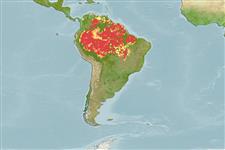Classification / Names
Common names | Synonyms | Catalog of Fishes (gen., sp.) | ITIS | CoL | WoRMS | Cloffa
Actinopterygii (ray-finned fishes) >
Characiformes (Characins) >
Ctenoluciidae (Pike-characids)
Etymology: Boulengerella: From George Albert Boulenger (1858-1937); he revised the works of Günther about Percoidei (Ref. 45335).
Environment / Climate / Range
Ecology
Freshwater; pelagic. Tropical, preferred ?
South America: Rio Amazonas, Rio Tocantins, Río Orinoco, Essequibo River, Oyapock River [= Rio Oiapoque] and rivers of Amapá, and Pará, Brazil.
Size / Weight / Age
Maturity: Lm ? range ? - ? cm
Max length : 88.0 cm FL male/unsexed; (Ref. 40637); max. published weight: 6.0 kg (Ref. 54653)
Dorsal
spines
(total): 0;
Dorsal
soft rays
(total): 10-11;
Anal
spines: 0;
Anal
soft rays: 9 - 11;
Vertebrae: 48 - 49. The location of the dorsal fin base distinctly anterior to the vertical through the anal fin origin distinguishes this species from all ctenoluciids except B. lucius and B. xyrekes, from which it can be distinguished by the discrete black spot on the basal portions of the caudal fin rays, and also by different pigmentation on the body.
Usually inhabits areas with rapid water, always on the surface, behind obstacles like rocks and logs (Ref. 54653). Some small-sized individuals occur in calmer waters such as lakes, small bays (Ref. 54653). Solitary or forms small schools (Ref. 54653). A carnivorous fish with preference on fish (Ref. 54653).
Life cycle and mating behavior
Maturity | Reproduction | Spawning | Eggs | Fecundity | Larvae
Vari, R.P., 1995. The Neotropical fish family Ctenoluciidae (Teleostei: Ostariophysi: Characiformes): supra and intrafamilial phylogenetic relationships, with a revisionary study. Smithson. Contri. Zool. No. 564, 97 p. (Ref. 13118)
IUCN Red List Status (Ref. 115185)
CITES (Ref. 94142)
Not Evaluated
Threat to humans
Harmless
Human uses
More information
Common namesSynonymsMetabolismPredatorsEcotoxicologyReproductionMaturitySpawningFecundityEggsEgg development
ReferencesAquacultureAquaculture profileStrainsGeneticsAllele frequenciesHeritabilityDiseasesProcessingMass conversion
Tools
Special reports
Download XML
Internet sources
